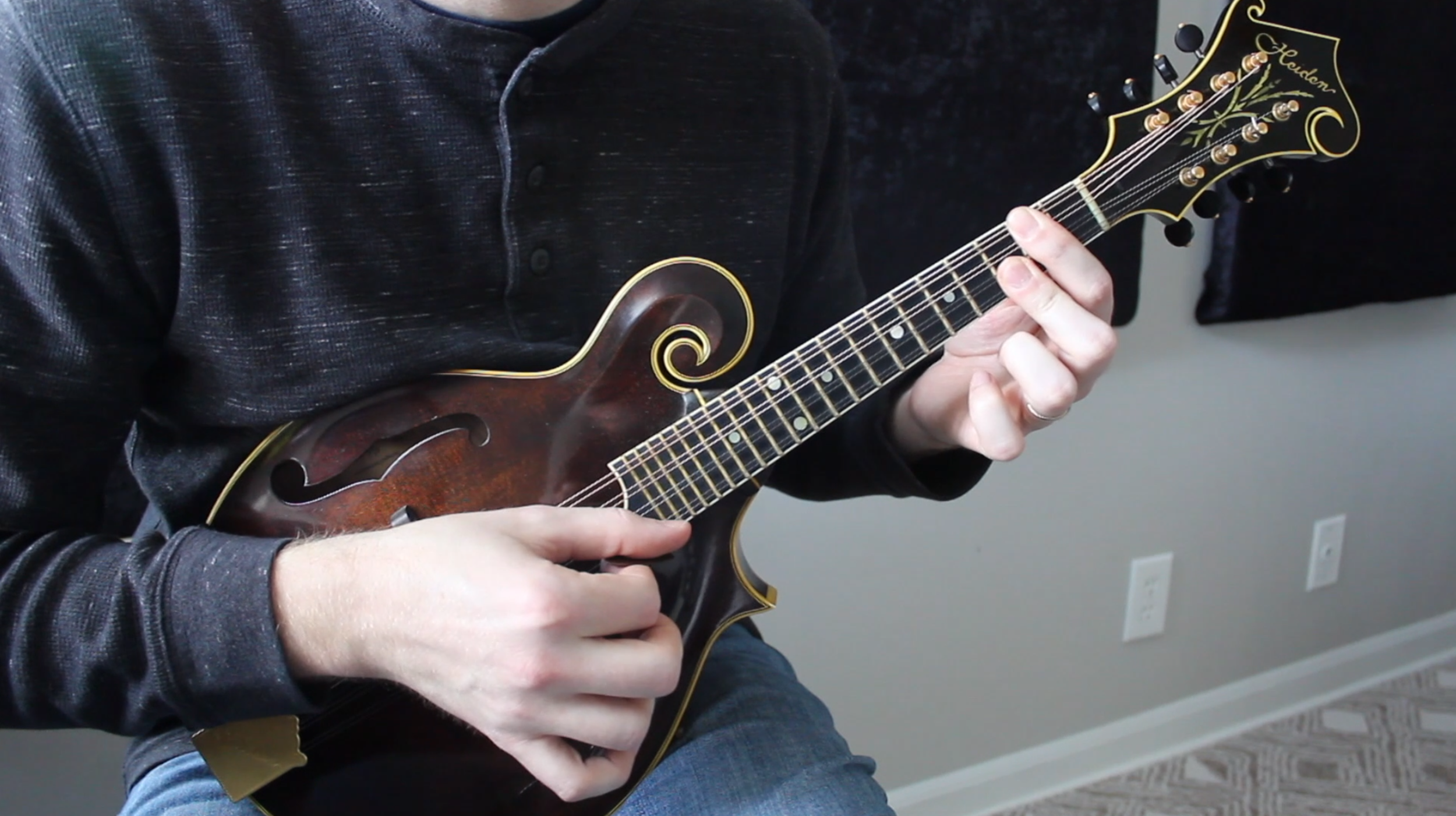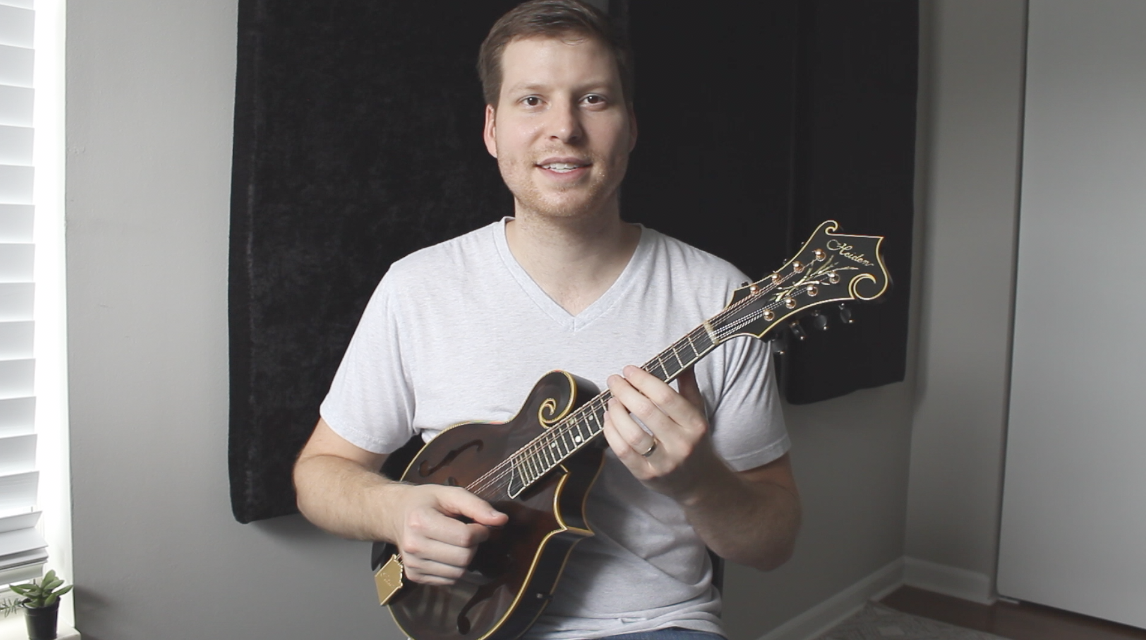This course is for all levels, from those who are just starting out and need to learn the fundamentals, to the more advanced players who want to improve their technique. The lesson starts with how I hold the pick and mandolin, and then I examine each component to how I move my hand, looking closely at the nuances to playing through the string. Then we look at how to achieve tone and efficiency using down strokes and alternating pick strokes, as well as the method for determining which pick strokes to play and when. Finally, we examine how the technique changes when playing at different tempos. Video comes with written hand-out that includes exercises for developing the right hand as well as sheet music for five fiddle tunes, all in standard notation and tab with pick strokes notated. Upon purchase, buyer will receive a PDF, which contains a link to download the video from Google Drive.
Duration: 47 minutes
This is the first lesson on my site to offer a variety of play-along tracks as part of the supporting material in addition to lengthy transcriptions of soloing ideas. “Improvisation 101” is a mandolin lesson for students of all levels, from the beginners who are getting their feet wet in soloing to the advanced players who are looking for more rich harmonic and rhythmic ideas to add to their vocabulary. The lesson starts by providing a foundation in basic music theory looking at the key of G major and the associated scales and arpeggios that can be made with those notes. Then, in the exercise portion of the lesson I demonstrate improvising lines that are typical for how I approach playing through chord changes in both bluegrass and jazz contexts. These demonstrations are accompanied by the play-along tracks of rhythm guitar and upright bass, which you also receive as mp3s to practice with. There are 8 different play-along tracks over the following chord progressions:
G major (bluegrass)
D7 (bluegrass)
G to D7 (bluegrass)
G to D7 (jazz)
Am7 to D7 (jazz)
G to Am7 to D7 (jazz)
C major (bluegrass)
G C D G (bluegrass)
You will also receive the PDF transcription book with all of these solos written in the form of standard notation and tab. This PDF contains a link to a Google Drive folder with all video and audio content. (This video has been uploaded at a higher resolution making it 6.6GB, which may require downloading it to your computer for proper playback.)
Duration: 44 minutes
Latin music has been largely unexplored by the American mandolin community. For this first instructional video of its kind, I break down some of the most important Latin/Afro-Caribbean rhythms that you should learn, diving into several music styles from Cuba. Part 1 of the lesson deals with son cubano, the quintessential style of Afro-Cuban music that is the basis for salsa and timba. I introduce you to some traditional lines that the cuban tres would play so you can started grooving with the congas and bass, as well as my own pattern that developed as I learned to adapt the mandolin to this style.
Part 2 introduces you to three other important rhythms that are relevant to the traditional Cuban repertoire - bolero, danzón, and cha cha cha. Again, I break down the basic rhythms and show you concepts for accompaniment in these styles.
This instructional video is my most elaborate to-date, featuring extensive audio examples and on-screen notation/TAB examples. Included with the package are audio files of 13 play-along tracks with percussion instruments like congas, bongó, guiro and bass to practice along.
Upon purchase, you receive a PDF e-book with all of the exercises and additional annotations. Contained within the PDF e-book is a link to a Google Drive folder where you can access all of the video and audio files.
Duration: 53 minutes
In this lesson, we first establish a concept for thinking about positions and then introduce the most essential shift moves to get started playing up and down the mandolin neck. Video lesson comes with extensive written materials in the form of standard notation with fingering numbers, as well as tab. Upon purchase, buyer will receive a PDF, which contains a link to download the video from Google Drive.
Duration: 25 minutes
In Shifting Positions (part 2), we continue the lesson with even more moves for shifting up and down the mandolin neck. Since we already established a base understanding of the concepts in Part 1, this second installment dives deeper and examines the most advanced techniques. Video lesson comes with extensive written materials in the form of standard notation with fingering numbers, as well as tab. Upon purchase, buyer will receive a PDF, which contains a link to download the video from Google Drive.
Duration: 26 minutes
In this lesson, we look at the most essential jazz chords on mandolin using the concept of “1 6 2 5” in the key of G major. Each chord change includes various substitutions and alternative voicings. Video lesson comes with extensive written materials including chord diagrams for every voicing. Upon purchase, buyer will receive a PDF, which contains a link to download the video from Google Drive.
Duration: 30 minutes
Jazz Chords (part 2) continues with an in-depth look at chords in the key of G major, this time going beyond the progression “1 6 2 5.” This lesson covers other common chord changes that occur in jazz tunes, such as going to the “4” and “6 minor” chords, always with numerous variations. Upon purchase, buyer will receive a link to download PDF, which contains a link to download the video from Google Drive.
Duration: 25 minutes
About the Video Lessons
Instructional Content.
My instructional videos are about topics that I think are important, and things that are key to my style of playing. You can find excerpts of all of these videos on my YouTube channel, as well as other free “mini-lessons.” As I continue developing these instructional videos, please feel free to let me know if there is a topic you would like me to create a video for!
Lesson format.
While my instructional videos tend to be unique on every topic I cover (I have priced them according to length and complexity) each video has a similar approach in that they are broken up into chapters, starting with the basic concept then getting progressively deeper. My goal is always to structure the lessons in a way that any mandolin player can easily get started and then continue building on those skills with each new chapter.
Supporting materials.
Along with each video, you receive a course hand-out that serves as supporting material for the video content. These PDFs vary depending on the concepts and content in the lesson. The lessons on jazz chords include many chord diagrams, while others may include exercises or transcriptions with standard notation, tab, finger numbers, and/or pick stroke symbols.









